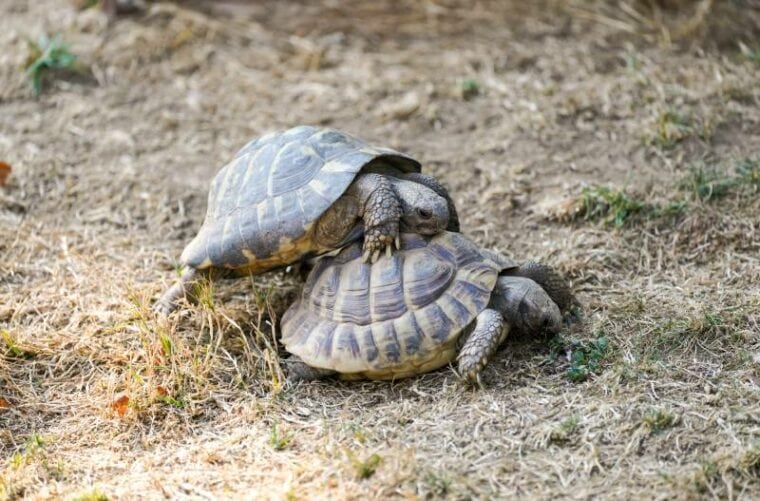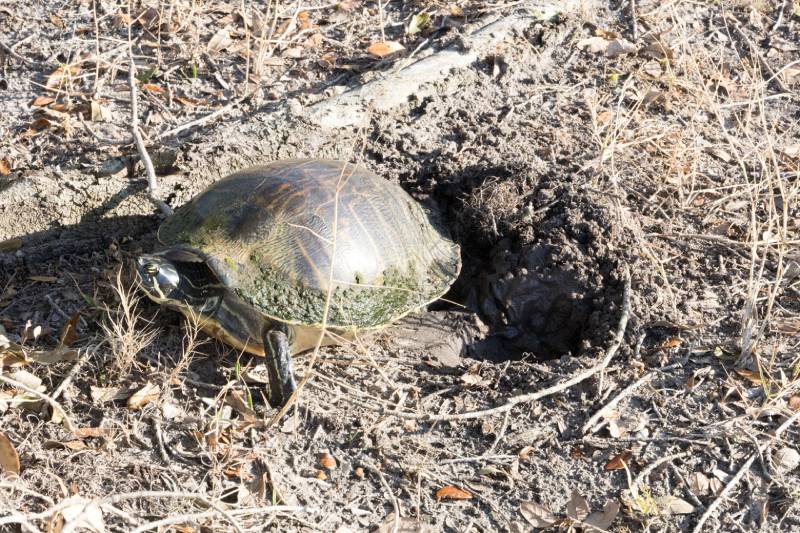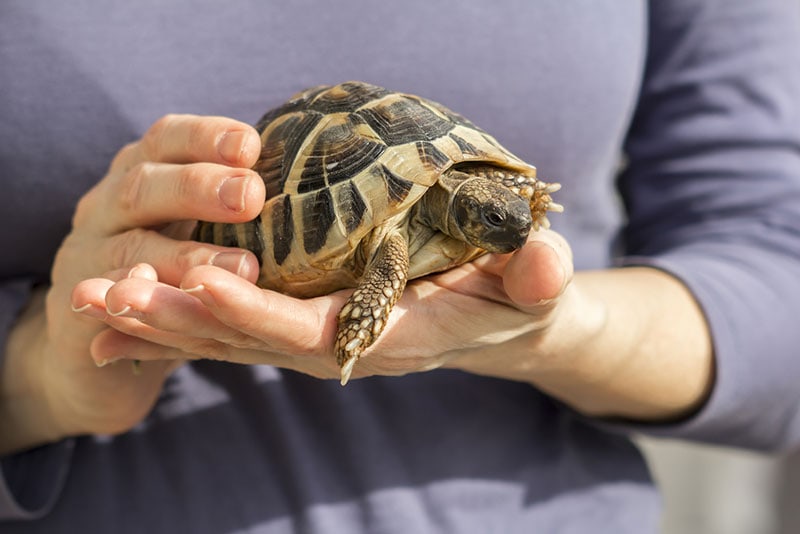
Click to Skip Ahead
If you’re just interested to know or have turtles and want to try your hand at breeding them, you’ll need to know about their mating habits. Their courting behavior and mating rituals vary depending on whether they’re an aquatic, semi-aquatic turtle or a terrestrial turtle (tortoise) and can be affected by their environment, age, and the time of year.
Breeding your turtles should be considered carefully and is not generally recommended for amateur or inexperienced keepers.
One of the biggest differences is where various turtles will breed. Aquatic turtles will mate in water, while tortoises will remain on land. We put everything that you need to know about a turtle’s mating habits into this guide, along with a few tips for preparing your pets for breeding.
How Do Turtles Mate?

The term “turtle” encompasses many different families. There are aquatic turtles, such as the sea turtle and smaller species that are commonly kept as pets, and terrestrial turtles, which are more commonly known as tortoises. They all have different courting and mating rituals. Therefore, the behaviors that you’ll need to watch out for will differ depending on the species of reptile that you keep.
Aquatic Turtles
Sea turtles and semi-aquatic turtles both keep their courting and mating rituals underwater. In the spring, a male turtle will swim around a female and stroke her head and neck with the claws on his front legs. If the female is receptive, she will return the gesture and eventually, dive deeper into the water as a signal that she’s ready to mate. The courtship may also include biting the neck, gular rubbing, cloacal checking and escorting the female around. Mating takes place in the water and the fertilization of eggs is internal.
Tortoises
Compared to the gentle courtship of the aquatic turtle, male tortoises are rougher in their search for mates. This aggression is directed at female tortoises and other males that are interested in mating with them.
Unlike aquatic turtles, tortoises mate on land. The male will bite the female’s head, limbs, neck, and the top of her shell to make her immobile, and then he will mount her.

When Do Turtles Mate?
It’s not just the presence of a healthy male and female turtle that decides whether they will mate. Their mating rituals also depend on the age of the turtles and the time of year.
Age
Like with all animals, turtles only start searching for a mate once they’ve reached sexual maturity. For wild turtles, this won’t be until they’re 15–20 years old or older, depending on the species. Pet turtles, however, can be much younger, particularly if they’re well-fed. Depending on the species, a pet turtle may reach maturity when they’re between 2 and 5 years old. Female turtles will often mature slower than males.
Mating Season
The time of year plays a big part in whether turtles will search for a mate. In the wild, turtles will brumate during the cold seasons. This is similar to hibernation, but instead of sleeping through the winter months, turtles will slow their metabolism, so they can be inactive and eat less.
Due to this habit, turtles won’t seek out a mate until the weather starts warming up. Lengthening days, warmer temperatures, and fluctuating barometric pressure can all affect different turtle species’ desire to breed.
If you keep your pet turtles in a terrarium with a steady temperature throughout the year, they’ll be more likely to engage in mating rituals more often. You should keep male and female turtles separate until you’re ready to breed them.

When Do Turtles Lay Their Eggs?
In aquatic and terrestrial turtle species alike, the females can store sperm deposited in their cloaca, (which is a chamber that their digestive, reproductive, and urinary tracts open into) in their oviducts. The oviduct is a tube that ova travels down, from the ovaries, and are turned into shelled eggs. It can remain viable for up to 3 years, enabling turtles to lay fertilized eggs within this period even if they don’t mate again. Their ability to store sperm and tendency to mate with more than one male means the eggs in one clutch can have several fathers.
All species lay their eggs on land, and female turtles can lay eggs without mating. So, whether you own aquatic turtles or tortoises, you will need to prepare a suitable nesting spot. This is essential even if you only own female turtles or never plan on breeding your pet. These eggs will be unfertilized and won’t hatch but are a natural part of your turtle’s life.
While chickens and ducks will lay eggs frequently, many turtle species will only lay a clutch of eggs once a year. Others might lay eggs more often but only during the nesting season.
When they lay eggs depends on the season, temperature, and whether your turtle can find a suitable nesting spot. Wild turtles often limit themselves to the warm seasons, so they will lay their eggs between May and September, while pet turtles will be more likely to lay their eggs at any time during the year.

How to Prepare Turtles for Breeding
Mating and reproducing is a completely natural part of your turtle’s life. You should always make sure you’re ready for the responsibility of looking after baby turtles before you allow your female and male pets to interact. Discussing the process with an experienced herpetologist or exotics veterinarian is a useful thing to do. Here are a few tips for preparing your turtles for breeding to ensure that the process goes smoothly.
Identify Your Turtle’s Sex
It might go without saying, but making sure you have a male and female turtle to breed is essential. Different species can look a bit different. For example, in some species, the females are larger than the males. That said, some of the differences are the same across species.
Male turtles will often have longer tails or foreclaws. The underside of their shell will also be slightly concave in shape to enable them to mount the female.

Prepare a Nesting Spot
Female turtles can be incredibly fussy when it comes to laying their eggs. Whether she’s an aquatic turtle or a land-dwelling tortoise, she will need a large, sandy area to lay her eggs. The spot needs to be warm—but not hot—with sandy or moist soil that’s deep enough for her to dig in. Separating the male and female turtles can help prevent the male from continuing to pester the female while she’s nesting.
Your female turtle might dig around for a bit before settling on the perfect nest. However, if she doesn’t lay her eggs at all, this can lead to several health issues. Preparing a suitable nesting spot is essential for the health of your turtle.
Use an Incubator
If you’re familiar with breeding chickens or ducks, you’re probably accustomed to using an incubator to help the process. You can use one for your turtles too. Once your turtle or tortoise has laid her eggs, collect the eggs carefully, and place them in an incubator. This will help you keep them in a controlled climate and monitor the hatching process.

Conclusion
Turtles have a similar mating process to that of other animals. Aquatic and terrestrial turtles alike will engage in courting behavior and mating rituals if they’re sexually mature and healthy.
Turtles will mate in water and tortoises will remain on land, but all turtle species will lay their eggs in nests dug into loose sand or moist soil. You’ll need to provide a large enough spot of land for your aquatic turtles or tortoises to ensure that they have somewhere suitable to lay their eggs.
Featured Image Credit: Elly Miller, Shutterstock









